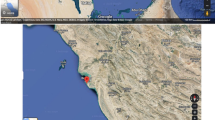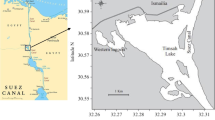Abstract
Halicarcinus planatus is the only member of the family Hymenosomatidae that occurs in the southern tip of South America. The aim of this study is to determine both the reproductive cycle and reproductive traits of the population of H. planatus nearest to southern limit of its geographical distribution. Results of this work allow us to determine two consecutive reproductive periods in this species. Maximum values of gonadosomatic index, oocyte diameter and ovarian development in March and August indicate that spawning takes place in May and September. The simultaneous ovarian maturity and the embryonic development show that female H. planatus can re-mature its ovary. The capability of H. planatus to develop their ovaries while females are ovigerous is a unique feature among the sub-Antarctic decapods and probably an adaptative advantage to extreme environments. Based on the different biological features and recent environmental changes along the Western Antarctic Peninsula, our hypothesis is that H. planatus possesses the potential to invade shallow waters and intertidal zones in this region.









Similar content being viewed by others
References
Alunno-Bruscia M, Sainte-Marie B (1998) Abdomen allometry, ovary development and growth of female sanow crab Chionoecetes opilio (Brachyura, Majidae) in the northwestern Gulf of St. Lawrence. Can J Fish Aquat Sci 55:459–477
Arntz W, Gorny M, Soto R, Lardies M, Retamal M, Wehrtman S (1999) Species composition and distribution of decapod crustaceans in the waters off Patagonia and Tierra del Fuego, South America. Sci Mar 63(1):303–314
Aronson R, Thatje S, Clarke A, Peck LS, Blake DB, Wilga CD, Seibel BA (2007) Climate change and invasibility of Antarctic benthos. Annu Rev Ecol Evol Syst 38:129–154
Atkinson A, Siegel V, Pakhomov E, Rothery P (2004) Long-term decline in krill stock and increase in salps within the Southern Ocean. Nature 432:100–103
Balestrini C, Manzella G, Lovrich G (1998) Simulación de Corrientes en el Canal Beagle y Bahia Ushuaia, mediante un modelo bidimensional. Serv Hidrog Nav 98:1–58
Boschi EE, Scelzo MA, Goldstein B (1969) Larval development of the crab Halicarcinus planatus (Fabricius) (Crustacea, Decapoda, Hymenosomidae) in the laboratory, with observations on the distribution of species. Bull Mar Sci 19:225–242
Boschi EE, Fischbach CE, Iorio MI (1992) Catálogo ilustrado de los Crustáceos Estomatópodos y Decápodos marinos de Argentina. Frente Marit 10:7–94
Clarke A (1982) Temperature and embryonic development in polar marine invertebrates. Int J Invertebr Reprod 5:71–82
Clarke A (1987) Temperature, latitude and reproductive effort. Mar Ecol Prog Ser 38:89–99
Clarke A, Murphy EJ, Meredith MP, King JC, Peck LS, Barnes DKA, Smith RC (2007) Climate change and the marine ecosystem of the western Antarctic Peninsula. Philos Trans R Soc Lond B 362:149–166
Comoglio L (1994) La nutrición de los crustáceos decápodos en el Canal Beagle, con especial énfasis en la centolla (Lithodes santolla) y el centollón (Paralomis granulosa), y la función trófica de los mismos en el ecosistema. Doctoral Thesis, Universidad de Buenos Aires, Argentina
Cook AJ, Fox AJ, Vaughan DG, Ferrigno JG (2005) Retreating glacier fronts on the Antarctic Peninsula over the past half-century. Science 308:541–544
Dellatorre FG, Barón PJ (2008) Multiple spawning and length of embryonic development of Munida gregaria in northern Patagonia (Argentina). J Mar Biol Assoc UK 88:975–981
Frederich M (1999) Ecophysiological limits to the geographical distribution of reptant decapod crustaceans in the Antarctic. Ber Polarforsch 335:1–133
Frederich M, Sartoris FJ, Pörtner HO (2001) Distribution patterns of decapod crustaceans in polar areas: a result of magnesium regulation? Polar Biol 24:719–723
García Raso J, García-Muñoz J, Manjón-Cabeza M (2008) First record of Munidopsis albatrossae (Crustacea: Decapoda: Galatheidae) from Antarctic waters. Polar Biol 31:1281–1285
Glorioso PD, Piola AR, Leben RR (2005) Mesoscale eddies in the Subantarctic Front, southwest Atlantic. Sci Mar 69(2):7–15
Gorny M, George M (1997) Oocyte development and gonad production of Nematocarcinus lanceopes (Decapoda: Caridea) in the eastern Weddell Sea, Antarctica. Polar Biol 17:191–198
Gorny M, Arntz WE, Clarke A, Gore DJ (1992) Reproductive biology of caridean decapods from the Weddell Sea. Polar Biol 12:111–120
Hartnoll RG (2006) Reproductive investment in Brachyura. Hydrobiologia 557:31–40
Hernando M (2006) Efecto de la radiación solar sobre el fitoplancton de aguas antárticas y subantárticas. Doctoral thesis, Universidad de Buenos Aires, Argentina
Hines AH (1982) Allometric constraints and variables of reproductive effort in brachyuran crabs. Mar Biol 69:309–320
Hoggarth DD (1993) The life history of the lithodid crab Paralomis granulosa in the Falkland islands. ICES J Mar Sci 50:405–424
Lovrich GA (1999) Seasonality of larvae of Brachyura and Anomura (Crustacea, Decapoda) in the Beagle Channel, Argentina. Sci Mar 63(1):347–354
Lovrich GA, Thatje S (2006) Reproductive and larval biology of the sub-Antarctic hermit crab Pagurus comptus reared in the laboratory. J Mar Biol Assoc UK 86:743–749
Lovrich GA, Vinuesa JH (1993) Reproductive biology of the false southern king crab (Paralomis granulosa, Lithodidae) in the Beagle Channel, Argentina. Fish Bull 91:664–675
Lovrich GA, Romero MC, Tapella F, Thatje S (2005) Distribution, reproductive and energetic conditions of decapod crustaceans along the Scotia Arc (Southern Ocean). Sci Mar 69(2):183–193
Lucas JS (1980) Spider crabs of the family Hymenosomatidae (Crustacea; Brachyura) with particular reference to Australian species: systematics and biology. Rec Aust Mus 33:148–247
Meredith MP, King JC (2005) Rapid climate change in the ocean west of the Antarctic Peninsula during the second half of the 20th century. Geophys Res Lett 32:L19604
Montes-Hugo M, Doney SC, Ducklow HW, Fraser W, Martinson D, Stamnerjohn SE, Schofield O (2009) Recent changes in phytoplankton communities associated with rapid regional climate change along the Western Antarctic Peninsula. Science 323:1470–1473
Pearse JS, Lockhart SJ (2004) Reproduction in cold water: paradigm changes in the 20th century and a role for cidaroid sea urchins. Deep Sea Res Part II 51:1533–1549
Pearse JS, McClintock JB, Bosch I (1991) Reproduction of Antarctic benthic marine invertebrates: tempos, modes, and timing. Am Zool 31:65–80
Pérez-Barros, P (2001) Crustáceos decápodos bentónicos asociados a la captura de Munida spp. (Decapoda: Anomura) en el Canal Beagle. Degree thesis. Universidad de Buenos Aires, Argentina
Pérez-Barros P, Tapella F, Romero MC, Calcagno J, Lovrich GA (2004) Benthic decapod crustaceans associated with captures of Munida spp. (Decapoda: Anomura) in the Beagle Channel, Argentina. Sci Mar 68:237–246
Retamal MA (2000) Decápodos de Chile CD-series. Biodiversity Center of ETI. Springer, Heidelberg
Richer de Forges B (1977) Etude du crabe des Iles Kerguelen: Halicarcinus planatus (Fabricius). Com Natl Fran Rech Antarct 42:71–133
Sahade R, Tatian M, Kowalke J, Kuhne S, Esnal GB (1998) Benthic faunal associations on soft substrates at Potter Cove, King George Island, Antarctica. Polar Biol 19:85–91
Sainte-Marie B (1993) Reproductive cycle and fecundity of primiparous and multiparous female Snow Crab, Chionoecetes opilio, in the northwest Gulf of Saint Lawrence. Can J Fish Aquat Sci 50:2147–2156
Smale DA, Barnes DKA (2008) Likely responses of the Antarctic benthos to climate-related changes in physical disturbance during the 21st century, based primarily on evidence from the West Antarctic Peninsula region. Ecography 31:289–305
Smale DA, Brown KM, Barnes DKA, Fraser KPP, Clarke A (2008) Ice scour disturbance in Antarctic waters. Science 321:371
Sokal RR, Rohlf FJ (1995) Biometry the principles and practice of statistics in biological research. W.H. Freeman and Co, New York
Somerton DA (1980) A computer technique for estimating the size of sexual maturity in crabs. Can J Fish Aquat Sci 37:1488–1494
Somerton DA (1981) Regional variation in the size of maturity of two species of tanner crab (Chionoecetes bairdi and C opilio) in the Eastern Bering sea, and its use in defining management subareas. Can J Fish Aquat Sci 38:163–174
Spivak ED (1997) Los crustáceos decápodos del Atlántico sudoccidental (25°–55°S): distribución y ciclos de vida. Invest Mar 25:69–91
Stebbing TRR (1914) Stalk-eyed Crustacea Malacostraca of the Scottish National Antarctic Expedition. Trans R Soc Edinb 50:253–307
Tapella F, Lovrich GA, Romero MC, Thatje S (2002) Reproductive biology of the crab Munida subrugosa (Decapoda: Anomura: Galatheidae) in the Beagle Channel, Argentina. J Mar Biol Assoc UK 82:589–595
Thatje S, Arntz WE (2004) Antarctic reptant decapods: more than a myth? Polar Biol 27:195–201
Thatje S, Fuentes V (2003) First record of anomuran and brachyuran larvae (Crustacea: Decapoda) from Antarctic waters. Polar Biol 26:279–282
Thatje S, Schnack-Schiel S, Arntz WE (2003) Developmental trade-offs in Subantarctic meroplankton communities and the enigma of low decapod diversity in high southern latitudes. Mar Ecol Prog Ser 260:195–207
Thatje S, Anger K, Calcagno JA, Lovrich GA, Pörtner HO, Arntz WE (2005) Challenging the cold: crabs reconquer the Antarctic. Ecology 86:619–625
van den Brink A (2006) The reproductive ecology and biology of the Pill-Box crab: Halicarcinus cookii (Brachyura: Hymenosomatidae) Filhol 1885. Master thesis, University of Canterbury
Vinuesa JH (1984) Sistema reproductor, ciclo y madurez gonadal de la centolla (Lithodes antarcticus) del Canal Beagle. Contrib INIDEP 441:75–95
Vinuesa JH, Balzi P (2002) Reproductive Biology of Lithodes santolla in the San Jorge Gulf, Argentina. In: Paul AJ, Dawe EG, Elner R, Jamieson GS, Kruse GH, Otto RS, Sainte-Marie B, Shirley TC, Woodby D (eds) Crabs in Cold Water Regions. University of Alaska Sea Grant College Program, , pp 283–304
Vinuesa J, Ferrari L (2008a) Postlarval development of Halicarcinus planatus females (Crustacea: Decapoda: Hymenosomatidae) in the estuary of the Deseado River, Argentina. Sci Mar 72:127–132
Vinuesa J, Ferrari L (2008b) Reproduction of Halicarcinus planatus (Crustacea, Decapoda, Hymenosomatidae) in the Deseado River estuary, southwestern Atlantic Ocean. Mar Biol 154:345–351
Watts J, Thatje S, Clarke S, Belchier M (2006) A description of larval and early juvenile development in Paralomis spinosissima (Decapoda: Anomura: Paguroidea: Lithodidae) from South Georgia waters (Southem Ocean). Polar Biol 29:1028–1038
Wenner A, Fusaro C, Oaten A (1974) Size at onset of sexual maturity and growth rate in crustacean populations. Can J Zool 52:1095–1106
Yaldwyn JC (1965) Antarctic and subantarctic decapod Crustacea. In: van Mieghem J, van Oye P (eds) Biogeography and ecology in the Antarctic. Junk, The Hague, pp 324–332
Zvyagintsev A, Kornienko E (2008) Discovery of larvae of the hermit crab Diogenes nitidimanus Terao, 1913 (Decapoda: Diogenidae) in ship ballast waters: Evidence in support of its introduction into Peter the Great Bay. Russ J Mar Biol 34:403–406
Acknowledgments
We are grateful to O. Florentín, F. Tapella, P. Pérez-Barros, M.P. Sotelano, M.C. Romero, G. Scioscia and M. Liljesthröm for their assistance in the field; to M. Kittlein for developing adaptation of MATURE routine for Excel. E. Spivak, S. Thatje, M.C. Romero and two anonymous reviewers provided useful suggestions for manuscript improvement. This study was funded by the Administración de Parques Nacionales (APN 829) and Agencia Nacional de Promoción Científica y Tecnológica (PICT 01-1385). MJD has a doctoral fellowship from CONICET, Argentina. This paper is based on work done by MJD in partial fulfilment of the requirements for the PhD degree at Universidad Nacional de Mar del Plata, Argentina.
Author information
Authors and Affiliations
Corresponding author
Rights and permissions
About this article
Cite this article
Diez, M.J., Lovrich, G.A. Reproductive biology of the crab Halicarcinus planatus (Brachyura, Hymenosomatidae) in sub-Antarctic waters. Polar Biol 33, 389–401 (2010). https://doi.org/10.1007/s00300-009-0716-0
Received:
Revised:
Accepted:
Published:
Issue Date:
DOI: https://doi.org/10.1007/s00300-009-0716-0




